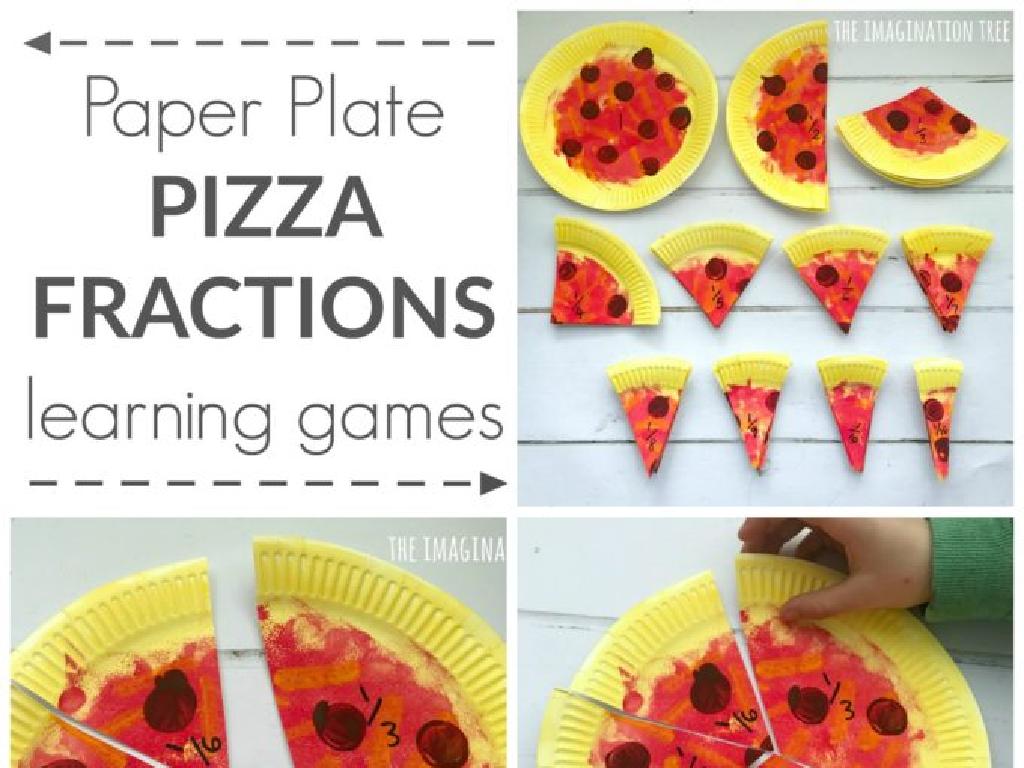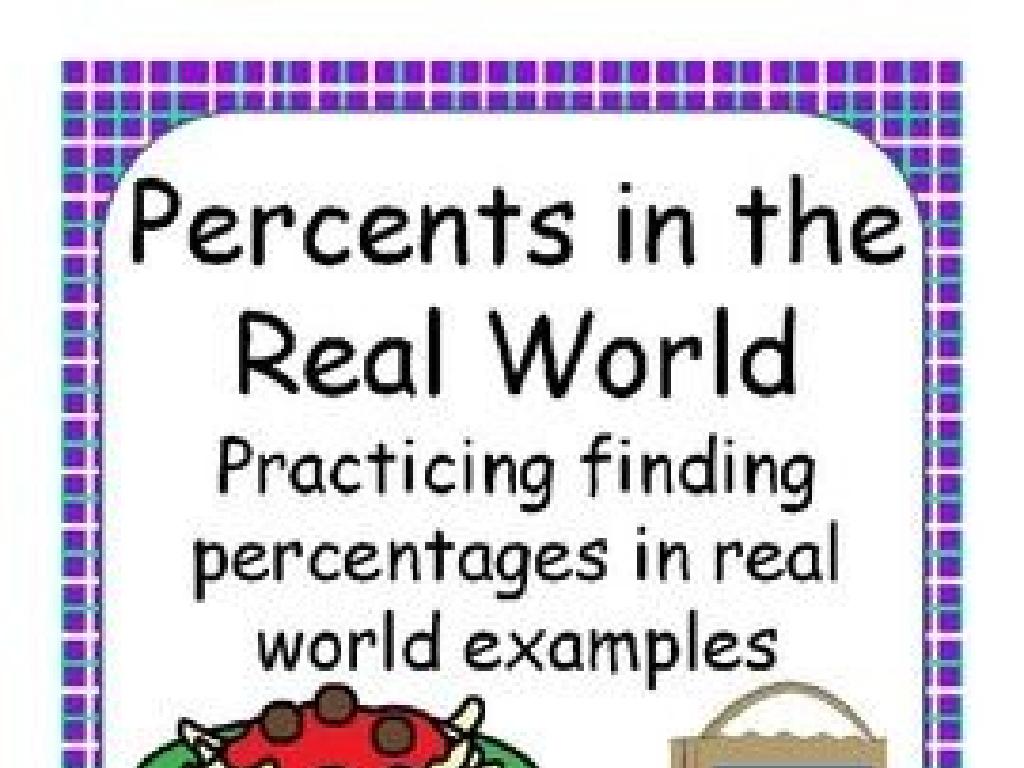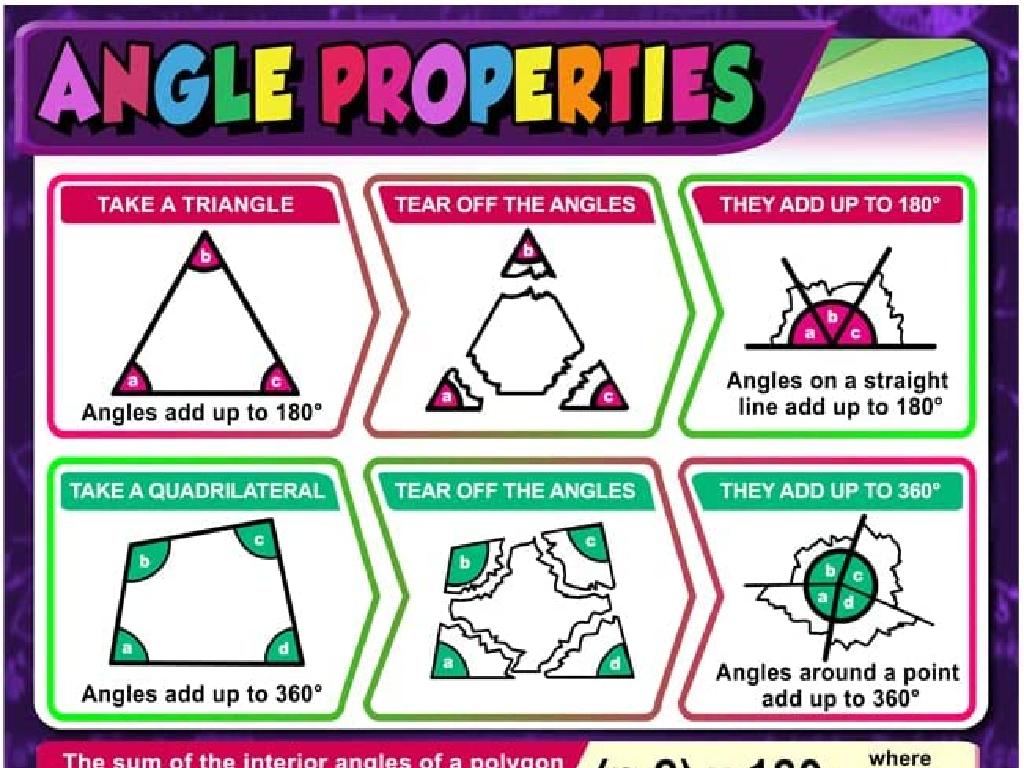Pronoun-Verb Agreement
Subject: Language arts
Grade: Third grade
Topic: Verb Types
Please LOG IN to download the presentation. Access is available to registered users only.
View More Content
Today’s Adventure: Pronoun-Verb Agreement!
– Pronouns & verbs must agree
– If ‘he’ is one boy, we say ‘he runs’.
– They work together in sentences
– Pronouns take the place of nouns, verbs show action.
– Agreement makes sense of sentences
– Without agreement, sentences sound funny!
– Examples: He runs, They run
– ‘He runs’ is correct, but ‘He run’ is not.
|
This slide introduces the concept of pronoun-verb agreement, which is crucial for constructing sentences that are grammatically correct and make sense. Emphasize that pronouns replace nouns and should match the verb in number and tense. Explain that proper agreement is essential for clarity in communication. Use simple examples to illustrate correct and incorrect agreements. Encourage students to think of their own examples and correct any mistakes they hear in everyday conversations. This will help them understand the importance of pronoun-verb agreement in making their sentences clear and understandable.
Understanding Pronoun-Verb Agreement
– What’s a pronoun?
– A word used instead of a noun, like ‘I’, ‘you’, or ‘they’.
– Examples of pronouns
– ‘He’, ‘she’, ‘it’, ‘they’ are all pronouns we use.
– Pronouns replace nouns
– Just like nouns, pronouns can be subjects, objects, or show possession.
– Pronouns & verbs must agree
– The pronoun and verb in a sentence must match in number and tense.
|
Begin by explaining what pronouns are and how they function as placeholders for nouns. Provide common examples that the students are likely to encounter in their reading and writing. Emphasize that pronouns can perform all the roles that nouns do within a sentence. Then, introduce the concept of pronoun-verb agreement, explaining that the pronoun and the verb must always match in both number (singular or plural) and tense. Use simple sentences to illustrate correct and incorrect agreement, and encourage students to create their own examples. This will help them understand how to use pronouns and verbs correctly in their speech and writing.
Understanding Pronoun-Verb Agreement
– What is a verb?
– A verb tells us what someone or something does
– Verbs show action or state
– Like ‘run’ for action, ‘is’ for a state of being
– Examples: run, is, have
– ‘He runs’, ‘She is happy’, ‘They have toys’
– Verbs: Heart of the sentence
|
This slide introduces the concept of verbs to third-grade students, emphasizing their importance in sentence construction. Verbs can represent actions like ‘run’ or states of being like ‘is’. It’s crucial for students to understand that a verb must agree with its subject in number and person, which is the foundation for teaching pronoun-verb agreement. Use examples that are easy for the students to act out or visualize. Encourage the students to come up with their own sentences using the verbs provided. This will set the stage for learning how pronouns and verbs work together to make sentences clear and correct.
Pronoun-Verb Agreement
– Pronouns & verbs must match
– Both need to agree in number (singular/plural) and person (first/second/third).
– ‘He’ pairs with ‘runs’
– For ‘he’, ‘she’, ‘it’, use singular verbs like ‘runs’, ‘eats’, ‘flies’.
– ‘They’ goes with ‘run’
– For ‘they’, use plural verbs like ‘run’, ‘eat’, ‘fly’.
– Let’s review examples!
|
This slide introduces the concept of pronoun-verb agreement, which is crucial for correct sentence structure. Explain that singular pronouns (he, she, it) require singular verbs, while plural pronouns (they, we) require plural verbs. Emphasize the importance of matching the pronoun in number and person with the correct form of the verb. Use examples to illustrate this point, and encourage students to come up with their own sentences. For instance, ‘She dances gracefully’ (not ‘dance’) and ‘They laugh loudly’ (not ‘laughs’). Engage the class with interactive activities where they correct sentences or create their own based on this rule.
Singular and Plural Pronouns
– Singular pronouns: he, she, it
– Plural pronouns: they, we
– Matching verbs to pronouns
– ‘He runs’ but ‘They run’ – verb changes with pronoun
– Practice with examples
– ‘She dances’ and ‘We dance’ – let’s find more examples!
|
This slide introduces the concept of pronoun-verb agreement to third graders, focusing on the difference between singular and plural pronouns. Emphasize that singular pronouns (he, she, it) are used for one person or thing, while plural pronouns (they, we) are for more than one. Highlight that verbs change depending on whether the pronoun is singular or plural. For example, ‘he runs’ uses a singular verb, whereas ‘they run’ uses a plural verb. Encourage students to come up with their own sentences using singular and plural pronouns with matching verbs. This will help them understand how verbs must agree with the pronouns in number. Provide additional examples and practice sentences to reinforce the concept.
Matching Game: Pronoun-Verb Agreement
– Match pronouns to correct verbs
– ‘He runs’ not ‘He run’. Which is right?
– Interactive game to boost skills
– Games make learning stick better!
– Ready to play and learn?
– Let’s have fun with grammar!
– Games turn lessons into playtime!
|
This slide introduces an interactive matching game to help students practice pronoun-verb agreement. The game will involve matching pronouns (e.g., he, she, it, they) with the correct form of verbs (e.g., runs, eat, goes) to reinforce the concept that verbs must agree with their subjects in number and person. Prepare a set of cards or an interactive digital tool with pronouns and verbs for students to match. You can create groups and have students compete to see who matches the most pairs correctly. Offer guidance and correct mistakes on the spot to solidify understanding. This activity will engage students and provide a hands-on approach to learning grammar.
Pronoun-Verb Agreement
– ‘He runs fast’, not ‘He run fast’
– ‘He’ is singular, so we use ‘runs’ to match it
– ‘They play at the park’, not ‘They plays at the park’
– ‘They’ is plural, so the verb ‘play’ doesn’t need an ‘s’
– ‘It is a sunny day’, not ‘It are a sunny day’
– ‘It’ is singular, so we use ‘is’ for one thing, not ‘are’
|
This slide presents examples of correct pronoun-verb agreement, which is crucial for constructing proper sentences. Emphasize to the students that the verb must agree with the pronoun in number. Singular pronouns require singular verbs, while plural pronouns require plural verbs. Use these examples to show common mistakes and correct them. Encourage students to think of their own sentences and practice this rule. During the lesson, have students come up with more examples and correct sentences that don’t follow the pronoun-verb agreement rule.
Let’s Practice Pronoun-Verb Agreement!
– Fill in blanks with correct verbs
– Practice makes perfect
– The more we practice, the better we get!
– Review answers together
– We’ll go over each answer as a class to learn
– Understanding through practice
|
This slide is for a class activity focused on pronoun-verb agreement. Students will be given sentences with missing verbs and must fill in the blanks with the correct verb form that agrees with the subject pronoun. Emphasize the importance of practice in mastering verb agreements. After the exercise, review the answers collectively, ensuring that students understand why each verb form is correct. This collaborative review process will help reinforce the rules of pronoun-verb agreement. Possible activities: 1) Pair students to compare answers before the class review. 2) Create a worksheet with different sentences for groups. 3) Have students come up with their own sentences. 4) Use a game format where students earn points for correct answers. 5) Encourage students to explain the reasoning behind their choices.
Class Activity: Pronoun-Verb Agreement
– Write sentences using pronoun-verb agreement
– Share your creative sentences with the class
– Example: ‘He runs fast’ or ‘They play together’
– Ensure pronouns and verbs are in agreement
– ‘She dances gracefully’ agrees, but ‘She dance gracefully’ does not
– Have fun and be imaginative!
|
This activity is designed to reinforce the concept of pronoun-verb agreement through creative writing. Encourage students to use their imagination to come up with sentences that correctly demonstrate pronoun-verb agreement. Provide examples of correct and incorrect agreement to guide them. Have students share their sentences with the class to create a collaborative learning environment. As they share, ask the class to identify the pronouns and verbs and verify their agreement. This will not only help students understand the concept but also allow them to practice speaking and listening skills. Possible variations of the activity could include creating a story together as a class, where each student contributes a sentence, or having students draw pictures to accompany their sentences.
Wrapping Up: Pronoun-Verb Agreement
– Importance of pronoun-verb agreement
– It helps our sentences make sense and sound right.
– Recap of today’s key points
– We learned pronouns must match the verbs in number and tense.
– Celebrate our learning success
– Practice makes perfect
– Keep practicing with more sentences at home!
|
As we conclude today’s lesson, emphasize the importance of pronoun-verb agreement in making sentences clear and understandable. Review the key points, such as singular pronouns matching singular verbs and plural pronouns with plural verbs. Congratulate the students on their hard work and encourage them to continue practicing with their reading and writing at home. This will help solidify their understanding and application of pronoun-verb agreement in everyday communication.






